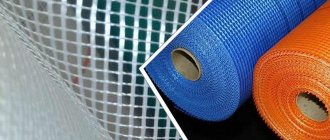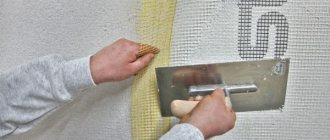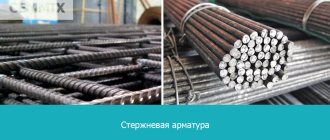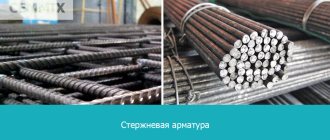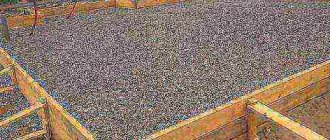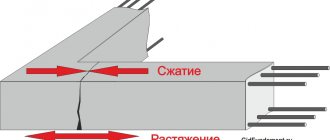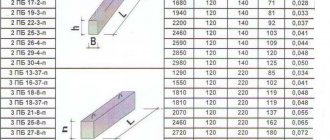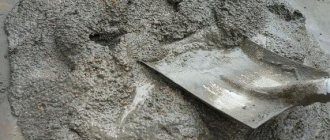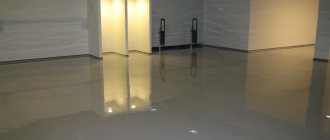- Metal grid
August 18, 2019
659
In certain situations, there is a need to reinforce the structure, which is carried out using a mesh. A natural question arises: “Why is a mesh in the foundation needed, what functions does it perform?” We will try to cover this topic in as much detail as possible in our article.
Construction of buildings for various functional purposes, civil, industrial facilities, various structures. In the majority of cases, it involves the arrangement of a foundation, which differs in its structural features and laying technology.
Reinforcement of monolithic reinforced concrete or why a mesh is needed in the foundation
First, the main thing is to understand the essence of the issue, the reasons for its occurrence and ways to solve it. Reinforcement using mesh is not always performed. Everything directly depends on the technology of laying the foundation, its type and material of manufacture. Let's start with the material, it can be different. Nowadays, in the predominant number of cases, concrete and its various grades are used. This is the first. Second. There are only two technologies for forming a concrete base - prefabricated and monolithic.
Prefabricated concrete, often reinforced concrete (with a steel reinforcement frame inside), or rather reinforced concrete structures are made in production conditions. They are brought to the site and laid on a pre-prepared base. These are products such as blocks, pillows, piles and a number of others.
The second technology involves the formation of reinforced concrete structures directly when laying the foundation. It is precisely in this situation that reinforcing and sometimes masonry mesh is used.
Application of the formula for calculating wall area
To calculate the total number of brick products, it is rational to use a method that is based on calculating the area of the walls. This value is found by multiplying by the number of bricks needed to build a brick wall measuring 1x1 m.
It is also important to take into account the fact that the thickness of the wall can be different, then the correct calculation will be where it will not be the area of the walls that will be calculated, but its volume directly. There is a formula we all know from school to help us:. V = a*b*c
V = a*b*c
The letter a denotes the height of the wall, b is the width of the masonry itself, c is the thickness.
Attention: when performing calculations, it is necessary to take into account openings for windows and doors, which must be subtracted, since they will not be included in the formula
The main differences between reinforcement and masonry mesh for the foundation
There are differences between them in the characteristics of the material and production technology. Masonry mesh with a small mesh size is usually made from metal wire with a diameter of up to 4 mm. There are also products made from composite materials (fiberglass), polymers, basalt and others. Delivered to the site ready for installation (in rolls or cards). Used in lightly loaded structures when constructing monolithic concrete foundations.
Reinforcing mesh, as the name implies, is made from reinforcement (classes A3 and C1, sometimes others). As a rule, this is black rolled metal (rod with a profiled surface), less often made of composite materials of a similar shape. The frame is formed either directly at the construction site, in the majority of cases, or, less often, delivered in the form of ready-made cards.
And the third of the identified criteria, which fully influences the relevance and method of reinforcement of the foundation, is its type. If we talk about monolithic concrete foundations, several types are used, such as:
- tape, various types of them, including slotted ones;
- tiled, monolithic slab over the entire area of the foundation;
- Columnar, columns are installed in the corners and at certain points.
A few important points. Firstly, sometimes combined solutions are used, when two types of foundation are combined with each other, for example, columnar-strip foundations. Secondly, sometimes foundations are laid that include both monolithic and prefabricated reinforced concrete structures. Thirdly, when columnar foundations are constructed, monolithic grillages are sometimes used. Or rand beams (differences in the type of connection with the pillars; the grillage is rigid, the rand beam is flexible). This is all important in terms of why and for what purpose a grid is needed in the foundation. We’ve sorted out the theory, now let’s move on to the essence of the issue discussed in the article.
Conversion tables m2 to kg
Welded mesh TU 14-4-1284-88
| Cell size x wire Ø | Weight 1 sq.m. in kg. |
| 16x24 light | 2.48 |
| 16x48 light | 1.99 |
| 24x48 light | 1.5 |
| 32x48 light | 1.25 |
| 32×24, 16×24 | 2.26 |
| 24x24 light | 1.97 |
| 16x24 galvanized | 2.81 |
| 16x48 galvanized | 2.24 |
| 24x48 galvanized | 1.7 |
| 32x48 zinc | 1.41 |
| 32×24+16×24 | 2.57 |
| 24x24 galvanized | 2.22 |
| TU 127500-245-00187211 | |
| 48x2.0 light | 1.01 |
Welded mesh made of VR-1 wire and B500S reinforcement in cards (sheets) cut to 2000x6000 mm
| Rod diameter, mm | Cell size, mm | Opening, mm | Weight m2, kg. |
| 4 | 100*100 | 2000*6000 | 1.84 |
| 4 | 150*150 | 2000*6000 | 1.22 |
| 4 | 200*200 | 2000*6000 | 0.92 |
| 5 | 100*100 | 2000*6000 | 2.88 |
| 5 | 150*150 | 2000*6000 | 1.92 |
| 5 | 200*200 | 2000*6000 | 1.44 |
| 6 | 100*100 | 2000*6000 | 4.44 |
| 6 | 150*150 | 2000*6000 | 2.96 |
| 6 | 200*200 | 2000*6000 | 2.22 |
| 8 | 100*100 | 2000*6000 | 7.9 |
| 8 | 150*150 | 2000*6000 | 5.26 |
| 8 | 200*200 | 2000*6000 | 3.95 |
| 10 | 100*100 | 2000*6000 | 12.34 |
| 10 | 150*150 | 2000*6000 | 12.38 |
| 10 | 200*200 | 2000*6000 | 6.19 |
| 12 | 100*100 | 2000*6000 | 17.8 |
| 12 | 150*150 | 2000*6000 | 11.84 |
| 12 | 200*200 | 2000*6000 | 8.88 |
If tables are not at hand, then the weight can be calculated this way:
- 1 meter of reinforcement = 1 m x (0.785 x L x D)
- The area of the circle is in parentheses. D - diameter.
- Specific gravity =7850 kg/m³
Factors affecting the foundation
So, when forming a monolithic concrete foundation (strip, slab, columnar, or a combination of them, including the use of precast reinforced concrete elements), a mesh, reinforcement or, less often, masonry is used. Why do this?
On the one hand, this is determined by the operational characteristics of the concrete itself. On the other hand, there are factors influencing it, such as:
- multidirectional loads;
- moisture (groundwater, precipitation, rarely, but sometimes - damage to utilities, water supply systems, drainage systems);
- ambient air temperature.
In turn, loads arise for a variety of reasons, among which the main ones are the structural and architectural features of a building or structure. And also the type and characteristics of the soil. All these parameters, often their combination, predetermine the need to use masonry or reinforcing mesh when constructing a monolithic concrete foundation. Although a lot still depends on the type of foundation. Let's talk about this in more detail.
How to make the right choice
The choice of reinforcing bars is based on design data and builder preferences.
Typically, metal rods are chosen, although composite reinforcement is increasingly used every year in the construction of strip foundations. Preference is given to metal rods due to the ability to give them the necessary bend, which is impossible to do with fiberglass rods.
This is especially important when constructing belts with curved sections or when there are fracture angles other than 90°. In addition, metal reinforcement is more economical, as it allows you to make clamps from a single rod, without the need to create several connection points
In addition, metal reinforcement is more economical, as it allows you to make clamps from a single rod, without the need to create several connection points.
The diameters of the rods have long been worked out in practice; they are often chosen without preliminary calculation - for a tape width of about 30 cm, a 10 mm rod is used, for tapes 40 cm wide, 12 mm rods are chosen, and for a width of more than 50 cm, 14 mm. The thickness of the vertical reinforcement is determined by the height of the tape; up to 70 cm, 6 mm is chosen, and for heights above 70 cm, 8 mm or more.
Characteristics of concrete and the influence of external factors on it
The key point that determines the need to use a mesh when arranging a monolithic reinforced concrete foundation is the characteristics of concrete. The compositions are different, they have different operational parameters. This is a topic for a separate discussion, but there are some common features. It is necessary to take into account such properties as:
- tensile and compressive strength, including axial strength, there are such key values as the class of concrete and its grade;
- material density;
- degree of waterproofness;
- frost resistance.
It is the combination of these parameters, together with the factors influencing them, that determines the need to use reinforcement for monolithic concrete foundations. Including using reinforcement or masonry mesh.
Tensile and compressive strength
We will not go into theory; now we are not considering the concrete itself, but we will note the need for its reinforcement in general terms. Multidirectional loads act on the foundation. Concrete copes well with compression, this is its main advantage. But the strength of this material decreases with shear. The situation is very bad with such types of influence as bending and tearing. It is precisely to ensure the integrity of the concrete base during shear, bending or rupture that reinforcement is included in it. That is, concrete resists compression. And the mesh compensates for shear, bending and provides the necessary degree of tear resistance.
Where do such bad loads come from?
First of all, everything depends on the soil on which the foundation is built. We are talking about soil characteristics. Let's look at the main ones, such as:
- load bearing capacity;
- frost heaving;
- subsidence (shrinkage).
There are others, of course, but these are the most important.
Mesh and ground shear compensation
The soil on which the foundation is built, heterogeneous in its structure, has varying degrees of saturation with soil water. You should also take into account the terrain and climatic conditions, the same freezing depth. The physical characteristics of the soil depend on this:
- water permeability;
- degree of plasticity;
- connectedness;
- friction;
- uniformity of composition;
- humidity and moisture capacity;
- blurability;
- compressibility;
- loosening.
It is these parameters that determine the degree of soil mobility. And when it moves, a corresponding shear force appears, acting on the concrete foundation. This is the first answer to the question that interests us. The mesh in the foundation provides compensation for shear forces and prevents tilting. The degree of mobility depends on the characteristics of the soil; we will not discuss this in detail. Let's put it this way - the less mobile the soil, the less the need to reinforce the foundation with a mesh. And on rocky soils, sometimes a foundation is not needed at all.
Frost heaving of soil and ways to combat it
Frost heaving is associated with the physical properties of water in the ground. When it's minus temperature outside, the water in the soil freezes and increases in volume. There is a rise and heaving (tangential or vertical) of the soil, a tensile force on the structure and its bending. The soil lifts the foundation, which leads to its delamination. And again, reinforcement mesh comes to the aid of concrete, which compensates for the effects of these negative forces. In this case, a lot depends on:
- soil porosity, the presence of pores can compensate for part of the expansion. Water, turning into ice, increasing in size, first fills the pores;
- structures, sandy (with a clay content of less than 15%) and rocky soils are not subject to heaving, but with clayey soils there is a problem;
- uneven heaving (in one season the soil can fall and rise several times);
- groundwater level, especially bad if it is higher than the freezing point of the soil;
- the weight of the structures, sometimes the mass is enough to compensate for the effects of heaving forces (two multidirectional types of loads). This is especially true for load-bearing walls made of stone materials (brick, various types of concrete, stone). But with lightweight structures, the relevance of using mesh increases.
In addition, it should be taken into account that the impact of heaving forces on the foundation of a building or structure is uneven. On the southern or illuminated side, the soil will warm up faster in the spring than on the northern or shaded side, and this leads to distortions. On the one hand, to prevent this, prepare the base from non-heaving or conditionally slightly heaving soils. In human terms, a sand cushion is placed under the foundation. On the other hand, they use mesh to reinforce concrete.
Tendency to shrinkage and force compensation
And another bad property of soil is its tendency to shrink. The soil compresses under the influence of loads and the higher these loads, the higher the degree of compression. By loads we mean the weight of structures with everything in them. Settlement occurs, if everything is calculated correctly - standard (within normal limits) and deflection. The mesh is precisely designed to compensate and prevent deformation of the monolithic concrete base during soil shrinkage.
We hope it is now clear that the use of mesh for reinforcing monolithic concrete foundations depends directly on the soil. And the impact on it of climatic conditions, groundwater levels and the structural features of the building itself.
But multidirectional loads are not all the reasons why a grid is used in the foundation.
Moisture and negative temperatures as negative factors affecting the foundation
A monolithic concrete foundation is affected by water in its various forms. Such as precipitation, groundwater or wastewater levels. This subsection partially overlaps with the previous one, because soil mobility depends on the groundwater level. And the degree of frost heaving depends on the volume of moisture in the soil and the ambient temperature. We will not duplicate, but will note several other important points. Water contains impurities, some of them are quite aggressive and can destroy the structure of concrete (at high oxygen concentrations). Delamination occurs, cracks and depressions appear. As a result, the strength of the foundation and its performance characteristics are reduced. This is on the one hand, on the other hand, water perfectly washes out the concrete base. And one more point - capillary moisture penetrates into the concrete structure due to the fact that the material has a certain degree of water resistance, but not 100%. Water, especially when freezing and expanding, damages the internal structure of the material. Thus, leading to a decrease in its strength characteristics.
There are several ways to combat these phenomena, one of them is increasing the strength of concrete by using a mesh. And the other is the correct arrangement of waterproofing, blind areas and storm drainage systems, engineering systems. For example, broken water pipes can damage the foundation.
Another important characteristic is frost resistance. Concrete freezes at negative temperatures, thaws at positive temperatures, and such cycles are repeated constantly. Because of this, changes occur in the structure of the material, it changes its properties, and strength decreases. The use of a grid in the foundation makes it possible to partially compensate for these losses in the operational parameters of the base of the building and structure.
Types of wire
According to GOST 3282-7, various types of general purpose wire are produced, however, only heat-treated wire is suitable for tying reinforcement. It is marked with the letter O. Annealing is used to return the product to its original ductility, which is lost during drawing.
The production process begins with broaching. At this stage, the product receives its geometric size. Next, it is sent to bell furnaces for firing in a nitrogen environment. Since the wire does not have contact with oxygen during annealing, its surface remains light and is not covered with scale. By this feature, you can distinguish rolled products made in accordance with GOST from lower-quality analogues. If the product was fired in oxygen, it will have a black coating that leaves marks on the hands. In this case, knitting of reinforcement with knitting wire is done while wearing gloves.
There is also galvanized binding wire. It is marked with the letter C. However, its use in monolithic works is not advisable, since the concrete solution reliably protects the connecting nodes from exposure to oxygen. It is more suitable for the construction of fences, the manufacture of gabions and other products that will be used in the air.
Which binding wire for reinforcement is better? There is no clear answer. The products are identical in their physical and mechanical properties. The question comes down to price, scope of use, convenience and speed of operation.
Structural features of the foundation
In addition to the properties of concrete and environmental factors affecting the foundation. Which determine the use of reinforcement or masonry mesh. Another reason for its use is the structural features of the foundation itself. Let's talk about this briefly.
In strip foundations, essentially, a monolithic reinforced concrete beam is laid. It sometimes works to deflect, absorbs and evenly redistributes the entire load from the building. Plus the soil subsidence, which has already been discussed. In order to compensate for bending and tearing forces and prevent concrete destruction, reinforcing mesh is used. Or a masonry mesh is used (consisting of longitudinal and transverse rods connected in a certain way). All this is done by longitudinal rods. The transverse ones hold the longitudinal ones and prevent their bulging, and compensate for transverse loads (shear).
Using grids in columnar foundations
In columnar foundations, the mesh provides reliable reinforcement for the monolithic column. It also prevents its deformation when exposed to forces on:
- shift due to soil mobility, the pillars “walk”, changing their position and verticality. Especially if the soil is weak or water-saturated, for example, swampy. Either mistakes were made during the design and installation of the foundation;
- compression - the total weight of the building;
- rupture, including those associated with frost heaving.
In addition, the grillage or rand beam is subject to the same forces as the strip foundation. That is, the relevance of using mesh for foundation reinforcement is the same. When a grillage is used, the steel mesh provides a rigid connection to the pillar.
Using a grid in a pillar foundation
The role of the grid in a slab foundation
In a slab foundation, in addition to all the listed problems, the grid also solves one more important issue. Which is directly related to the compensation of multidirectional loads. The thing is that this type of foundation has its own so-called punching zones. Where reinforcement is required to compensate for the loads acting on them.
To summarize, in a couple of sentences and answering the question: “Why do you need a grid in the foundation?” so to speak. On the one hand, to increase the strength of the base. On the other hand, to protect concrete from destruction and ensure the necessary operational parameters of the foundation. Moreover, concrete, in turn, guarantees the safety of the reinforcement and two-way communication.
It will be necessary to select steel reinforcement with a certain type of profile and diameter, steel reinforcing mesh in cards, masonry mesh in cards or rolls - contact us (link here). We recommend that you familiarize yourself with our assortment and ask any questions you may have. We will definitely help you with your choice.
An example of calculating the required parameters
Let's consider the calculation of reinforcement for a strip foundation using an example.
Let's assume that the height of the tape is 100 cm and the width is 40 cm (a common version of a shallow foundation).
Then the cross-sectional area will be:
40 • 100 = 4000 cm2.
We determine the total cross-sectional area of the reinforcement (minimum):
4000: 1000 = 4 cm2.
Since the width of the tape is 40 cm, 2 rods need to be placed in one grid, and the total quantity is 4 pieces.
Then the minimum cross-sectional area of one rod will be 1 cm2. Using SNiP tables (or from other sources) we find the closest value. In this case, you can use reinforcing bars with a thickness of 12 mm.
Determine the number of longitudinal rods. Let's say the total length of the tape is 30 m (6: 6 m tape with one 6 m jumper).
Then the number of working rods with a length of 6 m will be:
(30 : 6) • 4 = 20 pcs.
Determine the number of vertical rods. Let's say the pitch of the clamps is 50 cm.
Then, with a tape length of 30 m, you will need:
30: 0.5 = 60 pcs.
Determine the length of one clamp.
To do this, subtract 10 cm from the width and height of the section and add up the results:
(40 - 10) + (100 - 10) = 120 cm. The length of one clamp is 120 • 2 = 140 cm = 2.4 m.
Total length of vertical reinforcement:
2.4 • 60 = 144 m. The number of rods with a length of 6 m will be 144: 6 = 24 pcs.
NOTE!
The obtained values should be increased by 10-15% in order to have a margin in case of errors or unexpected material costs.
Methods for fixing joints
To reinforce the foundation, meshes are used, connected with wire using:
- pliers;
- small wire cutters with blunt cutting edges;
- a purchased or homemade hook of a certain shape;
- knitting gun.
Pliers and wire cutters are used for the simplest method of knitting mesh. At the intersection of the reinforcing bars, a wire folded in half is inserted from below, the ends of which are twisted using one of the tools. To prevent the finished twist from sticking out, it is bent closer to the mesh.
Special hooks are bought in hardware stores, markets, or made yourself from hard steel wire. Just as in the previous case, pre-cut soft wire rods are folded in half, with the only difference being that on the bend side a loop is formed into which a hook is inserted. The free ends are wrapped around the joint on the reinforcing mesh, bending them over the hook where the loop is already located. Now all that remains is to twist the wire, rotating the device until the connection is securely fixed.
- A simple hook is rotated by hand, which takes a lot of time.
- The screw hook makes work easier and faster. It is driven by pressing the handle.
- A screwdriver or drill helps speed up the assembly of the foundation mesh as much as possible. The hook is simply inserted into the chuck of a particular tool.
Knitting gun
Large volumes of work require mechanization and automation, otherwise the construction process may take a long time. The reinforcing mesh, in this case, is knitted using an electric (battery) or mechanical gun. A high-quality tool is expensive, but a low-quality one is enough for no more than one object. Private developers are getting out of this situation in different ways. Some people buy used equipment and then sell it, others rent a knitting gun, and still others are satisfied with a cheap fake, since they see no need for its further use.
Automatic fastening of reinforcement joints is carried out almost instantly, but it is not possible to use a gun in hard-to-reach places.
Knitting of the reinforcing mesh is performed after installing the working unit of the gun at the junction of two rods and pressing the start button. The knitting wire is fed automatically from a reel, which is one of the tool modules, so there is no need to pre-cut pieces for twisting. The advantages of using a pistol include:
- convenience and ease of operation;
- high quality butt joints ensured by constant twisting force;
- economical consumption of wire material, eliminating waste;
- knitting speed;
- significant reduction in labor intensity.
But we should not exclude the disadvantages of the automatic process, which consist in the need for staff training and material costs for purchasing the tool. In this regard, on small projects, which include private construction, knitting guns are practically not used.
Regardless of the chosen method of knitting the reinforcing mesh intended for the construction of the foundation, it is required to take a responsible approach to the work process. We should not forget that the durability of the structure and the reliability of its foundation will depend on the correctness and quality of assembly of the metal frame.
Methods for fixing joints
The accuracy and reliability of fixing the mesh nodes ensures the quality of the entire structure. According to approved work practice, the reinforcement must be connected by spot welding or special binding wire. Sometimes plastic ties and fastenings are used.
Different ways to fix joints
For private house construction, it is better to use tying wire. It provides several valuable advantages over welding:
- When fastening by welding, the structure of the reinforcement is destroyed. At the welding site, the metal rusts faster and fails.
- The wire allows the reinforcement to bend within tolerance. Welding eliminates this.
- When pouring the concrete mixture, the welding site may rupture, breaking the entire mesh.
- If the quality of the reinforcing bars is average, they may crack when welding.
- An experienced craftsman will use a hook to tie the mesh much faster than when welding knots.
Conversion tables m2 to kg
Welded mesh TU 14-4-1284-88
| Cell size x wire Ø | Weight 1 sq.m. in kg. |
| 16x24 light | 2,48 |
| 16x48 light | 1,99 |
| 24x48 light | 1,5 |
| 32x48 light | 1,25 |
| 32×24, 16×24 | 2,26 |
| 24x24 light | 1,97 |
| 16x24 galvanized | 2,81 |
| 16x48 galvanized | 2,24 |
| 24x48 galvanized | 1,7 |
| 32x48 zinc | 1,41 |
| 32×24+16×24 | 2,57 |
| 24x24 galvanized | 2,22 |
| TU 127500-245-00187211 | |
| 48x2.0 light | 1,01 |
Welded mesh made of VR-1 wire and B500S reinforcement in cards (sheets) cut to 2000x6000 mm
| Rod diameter, mm | Cell size, mm | Opening, mm | Weight m2, kg. |
| 4 | 100*100 | 2000*6000 | 1.84 |
| 4 | 150*150 | 2000*6000 | 1.22 |
| 4 | 200*200 | 2000*6000 | 0.92 |
| 5 | 100*100 | 2000*6000 | 2.88 |
| 5 | 150*150 | 2000*6000 | 1.92 |
| 5 | 200*200 | 2000*6000 | 1.44 |
| 6 | 100*100 | 2000*6000 | 4.44 |
| 6 | 150*150 | 2000*6000 | 2.96 |
| 6 | 200*200 | 2000*6000 | 2.22 |
| 8 | 100*100 | 2000*6000 | 7.9 |
| 8 | 150*150 | 2000*6000 | 5.26 |
| 8 | 200*200 | 2000*6000 | 3.95 |
| 10 | 100*100 | 2000*6000 | 12.34 |
| 10 | 150*150 | 2000*6000 | 12.38 |
| 10 | 200*200 | 2000*6000 | 6.19 |
| 12 | 100*100 | 2000*6000 | 17.8 |
| 12 | 150*150 | 2000*6000 | 11.84 |
| 12 | 200*200 | 2000*6000 | 8,88 |
If tables are not at hand, then the weight can be found out by simple calculations.
- 1 meter of reinforcement = 1 m x (0.785 x L x D)
- The area of the circle is in parentheses. D - diameter.
- Specific gravity =7850 kg/m³
How to knit
There are several most common options for producing meshes directly on the construction site. For this, wire or a more modern material is used - plastic clamps.
It will be more convenient to knit individual sections outside the trench. When installed in the design position, they are simply joined together in place.
To reinforce the foundation, you can use ready-made meshes produced in industrial conditions. They are made by flattening round rods, which ensures the reliability and strength of the joints. In this case, welding is not used, so the characteristics of the metal elements do not deteriorate.
Wire
The foundation mesh used for reinforcement is knitted with soft, easily bendable metal wire made from low-carbon steel. If it is difficult to bend, it can be heated over a fire for 30 minutes and then cooled. According to experts, the problem disappears in most cases. The metal may be galvanized or not have any protective coating. The optimal wire diameter for knitting is considered to be 1.2-1.4 mm. It is cut in advance into pieces of 10-20 cm.
Plastic clamps
Convenient, simple and fast, but is it reliable? Plastic clamps have appeared on the market recently, so the question of their strength worries many developers. There is no one hundred percent trust in them yet, but it is known for sure that they can burst in the cold, so they should not be used for work in winter, and also for the construction of large objects. Self-tightening plastic clamps are recommended for tying together metal rods when constructing foundations for country houses or utility buildings if the underground part requires reinforcement. They also bind composite reinforcement.
In addition to clamps, there are ready-made staples and clamps made from wire on the market. When using them, no tools are needed - the mesh is knitted by hand.
